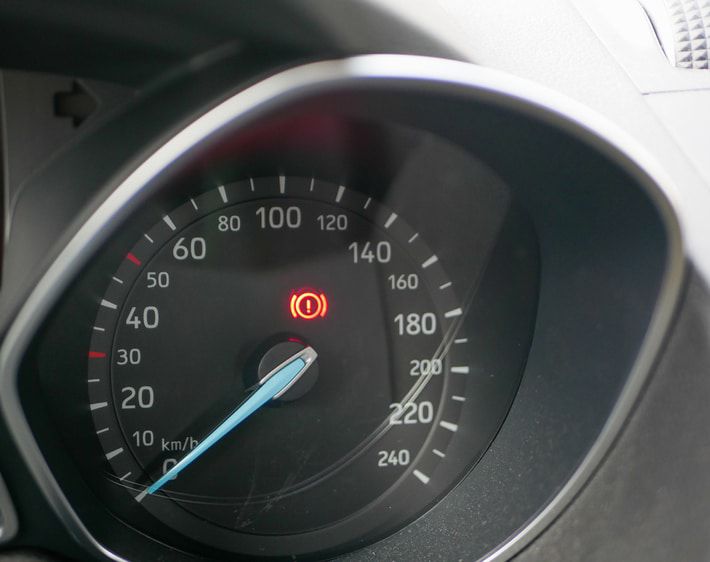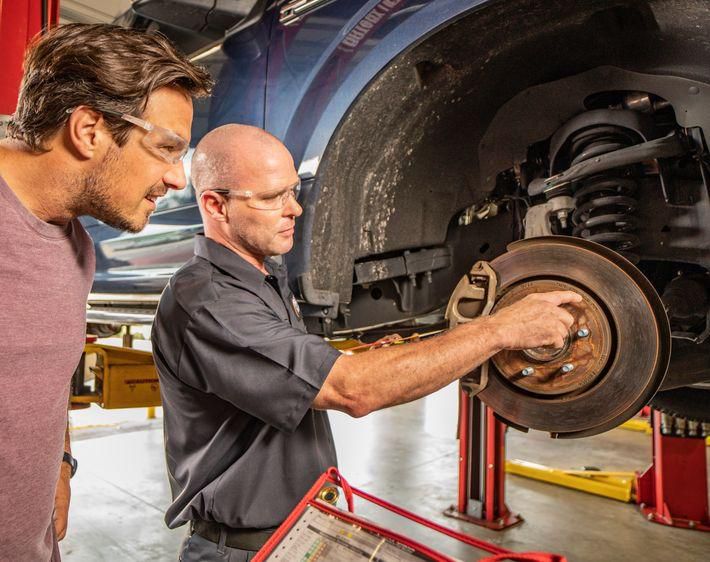Some dashboard lights are simple service reminders, while others are cries for help from your car! A brake system dash light falls in this second category.
If you see a service brake system light illuminate, don’t ignore it — find out what could be causing your dashboard brake light to come on, and what you can do about it.
What is the Service Brake System Light?
Most cars on the road today have at least one dashboard light that corresponds to the braking system. Many have two or even three lights, including one that notifies the driver when the ABS comes on, another that lights up if the parking brake is active, and another that alerts drivers when something is wrong with the overall braking system.
These lights have individual and shared triggers that vary depending on the make, model, year, and features of your vehicle. For the most precise guide on what your dashboard lights mean, consult your owner’s manual after going over these general guidelines.
- The ABS light typically consists of the letters “ABS” surrounded by a circle with parentheses-like curves on either side of it. The light comes on at brief intervals when the anti-lock braking system mechanism kicks in. But if it’s continuously lit, you may have a problem.
- The parking brake light looks a lot like the ABS light, but rather than having multiple letters within a circle, it has a standalone capital P or exclamation mark. In some cases, the word “BRAKE” is also above or beneath the circle. Generally, this dash warning comes on when you attempt to move your car with the parking brake engaged. If it remains on after disengaging the parking brake, check out the possible causes in the next section.
- The BRAKE light is simply the word “BRAKE.” Sometimes, it is used interchangeably with the parking brake light to denote when this is active. Likewise, if it is on while you are driving without the parking brake engaged, you may have brake issues.
Generally, if any of the lights above become illuminated out of turn, you should treat it as a service brake system light or brake warning alert. The situations below are a few reasons why a brake warning light in your car may come on.
1. Your parking brake is on.
Do you ever put your car in drive and hit the gas only to realize you’ve left the parking brake on? It happens to everyone, and, most of the time, it isn’t a cause for concern. However, don’t make a habit out of it or you could cause your brakes to wear prematurely. If you release the parking brake only to realize the light stays on, there may be other factors at play.
2. Your parking brake switch is not working correctly.
If you release your parking brake using a lever on your center console or by the pedals, you have a mechanical parking brake system. If you use an ignition switch to enable and disable the parking brake, you have an electronic parking brake system, which is common in more recent models.
Whether you use a switch or a lever to control your parking brake, if the light stays on after disabling it, there might be something wrong with this control mechanism. Get it checked out by a professional to find out if the switch/lever is the problem, or if another different issue is to blame.
3. You’re low on brake fluid.
If you’ve engaged and disengaged the parking brake and one or more brake lights on your car are still on, you may be low on brake fluid. Brake fluid lubricates and protects the brake components in your system, and helps turn your foot’s pressure on the brake pedal into the mechanical action required to stop your car!
Low brake fluid levels usually occur due to leaks, which should be diagnosed and repaired by a certified technician. You can check your brake fluid levels at home or get a professional opinion with a free brake inspection from local Tires Plus.
4. You need a brake fluid exchange.
Even though your brake fluid flows within a closed system, it can become contaminated by an issue in the system or lose its protective quality due to age. Moisture-contaminated brake fluid can cause brake components to corrode (since these are largely made of steel or aluminum), and end up leading to more costly repairs!
During a brake fluid exchange, contaminated fluid is replaced with fresh fluid. Typically, only newer vehicles alert you to the need for a brake fluid exchange with a warning light, so don’t wait for it to come on to get your next service! Always check your owner’s manual to find out how often you need a brake fluid exchange.
5. Your brake pads are worn.
Depending on your car make, model, and year, your service brake system light may become illuminated when the brake pads need to be replaced. However, like with brake fluid contamination, your car may not alert you to the need for new brake pads with a light.
Certain models might show other signs of brake pad wear like grinding or screeching sounds, a pulsing or vibrating of the steering wheel or brake pedal, or the need to press the pedal more aggressively to stop your car. Use your manufacturer's recommended maintenance schedule to keep up with brake inspections and brake pad replacements.
6. Your ABS is malfunctioning.
Your anti-lock brake system dash signal may light up briefly when the ABS kicks in to help you steer your car in slippery conditions. However, if your ABS light comes on and stays lit or begins flashing intermittently, it’s trying to tell you there’s something wrong with the system.
ABS issues that may trigger the light include a blown fuse, a damaged or contaminated sensor, frayed or broken wiring, or a faulty controller. Without a working ABS, you’re more likely to lose traction, experience wheel lockup, or lose steering control under certain conditions, so keeping your brakes in tip-top shape is vital. The good news is that you can get ABS light diagnostics and anti-lock brake system repairs at your local Tires Plus.
7. Your light needs to be reset.
Typically, service brake system lights let you know when there’s something off with the braking system. In some cases, the lights themselves can malfunction, too — blinking or turning on for no mechanical reason. Without a professional opinion, it can be difficult to tell these two situations apart, so you shouldn’t attempt to diagnose or reset your brake light by yourself.
Instead of asking yourself, “How do I reset this dash light?” get a professional opinion from an auto technician near you.
Stop for Safety!
At the end of the day, dashboard lights are largely designed to alert you when something’s wrong with your car, so you can take proactive steps to fix it! When you notice your service brake system light goes off, stop in for a free brake check. We will check out your vehicle and show you the best options for you so you can choose what you want. We may be under-the-hood, but you’re behind-the-wheel.



